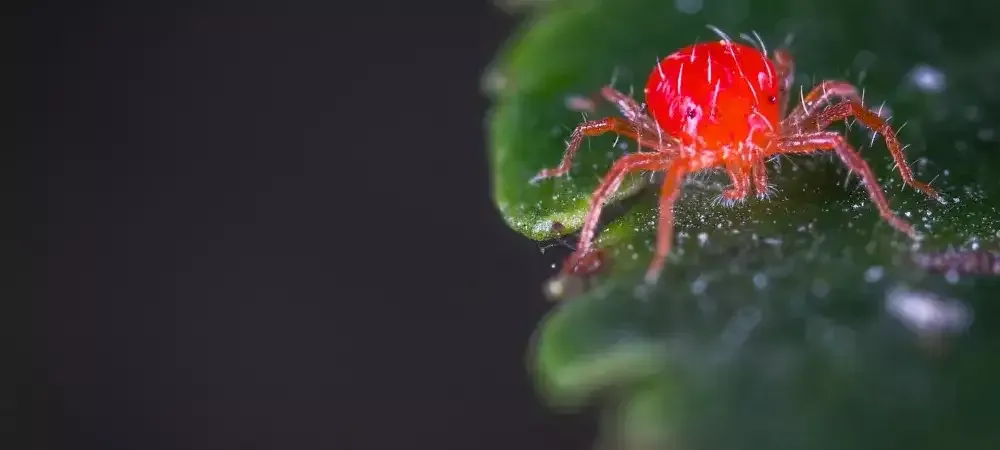How to Prevent and Control Spider Mites In Your Lawn (Updated 2025)

Spider mites have many names, including turf mites, grass mites, lawn mites, or yard mites, but can cause severe damage to your turf and landscape. Learn how to identify, prevent, and get rid of these lawn pests.
What Are Spider Mites?
Spider mites is a collective term for a number of different species of garden pests which can damage or even potentially kill the plant life in your yard. They are a very common pest—and while they may not present any threat to you directly, they should still be dealt with quickly to help prevent extensive damage to your flora.
What do Spider Mites Look Like?
True to their name, spider mites are in fact members of the arachnid class rather than insects, and thus, as adults, have eight legs. Their bodies are incredibly small, oval-shaped, and vary in color, ranging from green and yellow to reddish-brown or even black. Most commonly though, they appear red, leading to the common moniker “the little red bug.”
How to Spot Spider Mites
Spider mite eggs are transparent when first laid, but will darken as the larvae prepare to hatch. Usually, a single individual mite will be very difficult to spot, however, a spider mite swarm should be very noticeable as they will begin to web over the plant in which they are feeding. Further, the plant may begin to yellow and stop growing, making their presence even more noticeable.
Do Spider Mites Bite?
While spider mites do bite plants when feeding, they do not bite humans. Unlike similar mites, like scabies mites, which love to feed on humans, spider mites prefer food of the greener variety. As always, we wouldn’t recommend taking a bath in spider mites, but you and your pets will be safe from spider mite bites in ordinary encounters.
Common Types of Spider Mites
Below are some of the most common kinds of spider mites and some of the slight differences which may help you identify them and coordinate with your pest control expert as to the best method of removal.
Below are some of the most common kinds of spider mites and some of the slight differences which may help you identify them and coordinate with your pest control expert as to the best method of removal.
Banks Grass Mites
- Most common mite species.
- Extremely small (under 0.5mm), oval-shaped, and ranges from green to black.
- Thrives in hot, dry conditions, with peak activity in summer.
- Rapid reproduction in warm climates, making early detection critical.
Clover Mites
- Slightly larger than banks grass mites.
- Almost always a reddish-brown color, commonly known as “the little red bug.”
- Prefers cooler weather, with peak activity in early spring and late fall.
- Can infest homes during sudden weather changes—vacuum instead of crushing to avoid red stains.
Winter Grain Mites
- Similar body shape and size to clover mites.
- Distinguishing feature: bright red-orange legs.
- Most active in winter, with another peak in early spring.
- Prefers wheat fields, making farmers more at risk than homeowners.
How to Tell If You have Spider Mites
Spotting a single spider mite is tough, but their activity signs are much easier to identify:
- Tiny, light-colored dots appear on leaves—early signs of mite feeding.
- Leaves begin to lose color, turning yellow or red and falling from the plant.
- By this point, the signature spider mite web should be easily visible.
Don’t think only outdoor plants are at risk! Indoor plants can also be affected.
How to Prevent Spider Mites in Your Lawn
Now that you know all about the risks, it is time to present some solutions. Prevention, as with all things pest-related, should be prioritized over everything, as there can be no spider mite problem to fix if there are no mites to begin with.
- The number one prevention method is water, as spider mites cannot survive in highly moist environments. Particularly through dry spells, make sure that all your plants are well watered. For added effectiveness use cold water, as the lower temperatures make it even harder for mites to thrive.
- You can also introduce a predatory species to your yard that will feed on mites if they appear. Ladybugs, Predatory Mites, and even the aptly named Spider Mite Destroyers make it their job to hunt down spider mites and can thereby keep all of your plants protected.
How to Get Rid of Spider Mites
If the prevention hasn’t worked and you are suffering from an infestation with plants dying left and right, all is not lost.
- Again, for large populations of mites, the best solution is water. It will need to be more aggressive this time, so any high-pressure water dispersion system can give your plants a good clear, taking the mites, webs, and eggs all together.
- Another option is a number of different organic oils such as neem oil, canola oil, or cottonseed oil all prove to be effective mite removal tools and they are very likely to be lying around the house, so make sure to take a look.
- There are obviously also chemical solutions to mites, but be very careful when choosing which insecticide to use as many of them contain extremely toxic chemicals. If in doubt be sure to consult with a professional pest control expert.
Hopefully, this has provided you with an insight into spider mites and given you some ideas on how to protect your plants. If you need any other help, advice, or have pest-related questions, make sure to give us a call, as our team of local experts at American Turf & Tree Care is always here to help.
